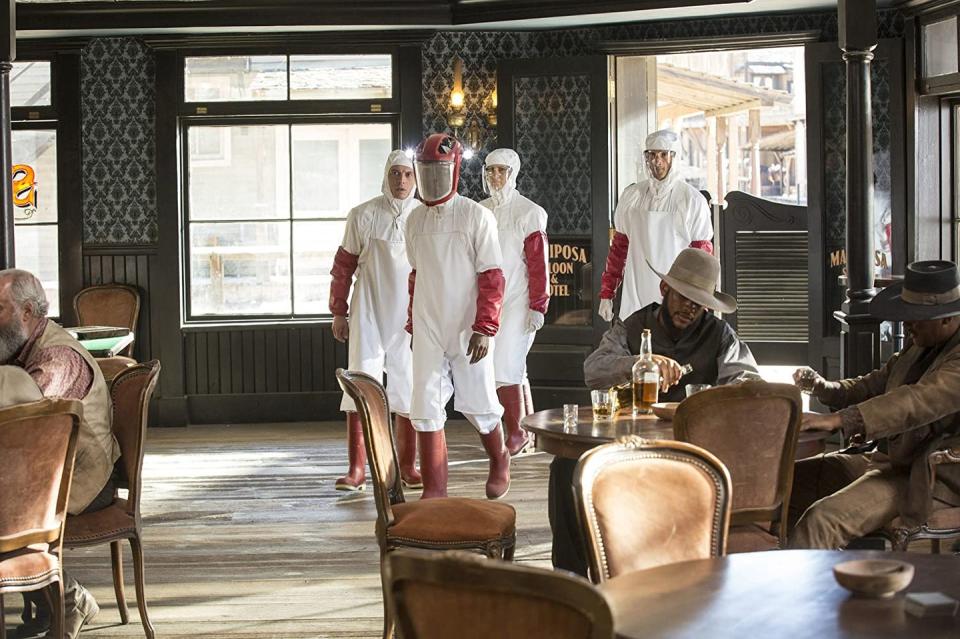How the Math Problem That Broke ‘Westworld’ Actually Isn’t Impossible

Warning: the following contains spoilers for episode 2 of Westworld
Westworld episode 2 features yet another simulation, this time trapping Maeve.
Maeve is able to break the system, however, by asking it to perform the math problem "the square root of negative one."
Here's why √(−1) is impossible to solve (using real numbers)
It's a simulation inside a simulation, Morty! Well, not quite. But episode 2 of the third season of Westworld played a bit of reality trickery, before the math equation "the square root of negative one," or "√(−1)," caused everything to go to hell.
Maeve, waking up in what can only be described as "Nazi World," an apparent park set in Nazi-occupied Italy, learns that this park is actually a virtual park; everything is made of code. Of course, that code was designed by humans. And human coders cut corners, apparently, meaning the code isn't very complex. And a not very complex code means the overall system cannot handle multiple complex commands simultaneously. Ask it to perform two difficult tasks at once and it shuts down. Apparently. What do we know?
Maeve decides those difficult tasks should be throwing a statue and asking two virtual lab technicians to answer a math problem.
“I wonder if you’d be able to help me solve a little problem: what is the square root of negative one?” Maeve asks.
"Well, negative one equals ‘i’ times ‘i’," one responds.
"Which is the same as ‘the square root of negative one times the square root of negative one,'” adds the other.
The two technicians then prattle on about various ways of formulating the equation. Maeve throws the statue. And things start to glitch. Here's why.

What is the square root of negative one?
First, think about how we take the square root of any positive number. What we're doing is finding the product of two identical values which gives us the value under the radical. So "√(4)", for instance, gives us both "2" (“2 x 2 = 4”) and “-2” (“-2 x -2 = 4”). "√(4)" can also be written as "√(2) x √(2)" or "√(4) x √(1)."
That's all well and good for positive numbers, but when we take the square root (sometimes called "principal square root") of a negative number, we get chaos. That's because the square root of any real number cannot be negative. Or: you can't derive a negative by multiplying two identical numbers together. So "√(-4)", for instance, cannot be written using the product of two identical values. (Nothing multiplied by itself gives us -4, or any negative number.)
So what do we do? We use a different unit. For the most basic negative radical "√(−1)" mathematicians assign the value "i" ("√(−1) = i"). The value "i" is simply an imaginary number that stands in the place for the value √(−1). That allows for other negative radicals to be written using "i." So "√(-4)" then becomes "2i" ("√(4) x √(−1)").

So, in the end, Maeve's request really shouldn't have broken the system, as the system should have a way of handling √(−x), a function that would just need to spit out imaginary numbers.
But perhaps it wasn't so much the system as the minds behind the system who caused the glitch.
What the technicians seem to be arguing about is if "i" is even a satisfying solution to √(−1). One tech wants to say that "i = √(−1)" is actually false. This claim is often made by showing how attempts to simplify the equation leads to contradictory answers. (If you want to know how the heck that works—and if you're not already frozen like Nazi World—head over to Khan Academy here, you know, the place that helped you pass calculus.)
It could just be that two real programmers somehow imputed competing views on simplifying √(−1) ? Who knows? Trying to figure out why Nazi World crashed ends up being more confusing than the actual math problem itself.
You Might Also Like

